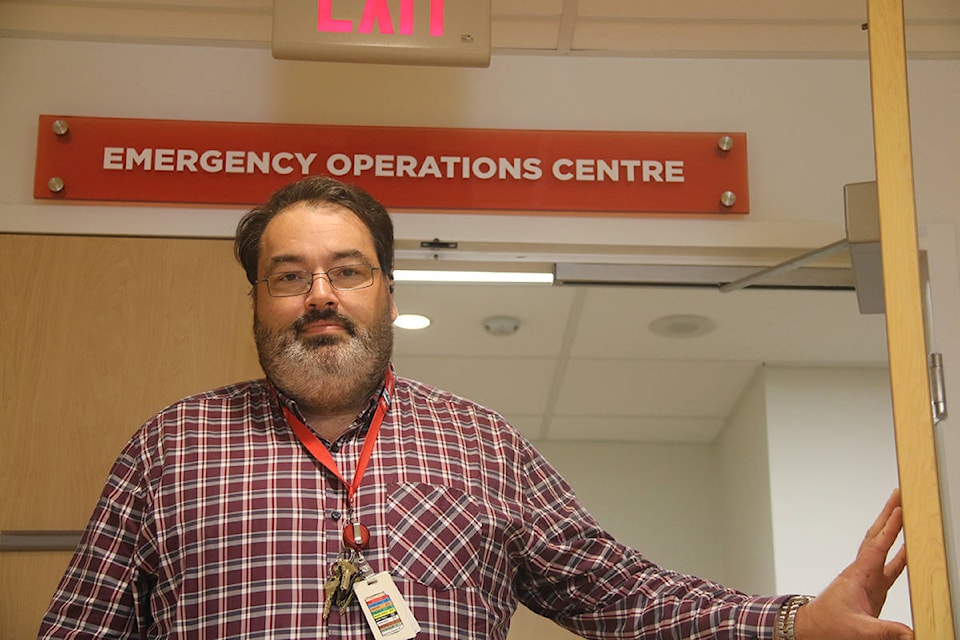This is part five of a special eight-part report done by Black Press Media on emergency preparedness in Greater Victoria. Find the series online at vicnews.com/tag/greater-victoria-emergency-preparedness.
Hospitals are meant to be there in a time of crisis, but that doesn’t happen without preparation.
Gerry Delorme, Island Health’s director for health emergency management B.C., is the mastermind behind what he called the organized chaos that descends upon health facilities in times of emergency.
Delorme and a small team work to prepare the health system, dealing with mitigation, response operations, recovery operations and everything in between.
He sat down with Black Press Media to discuss how a hospital would prepare in the event of a natural disaster. Seated at a table outside Royal Jubilee Hospital, Delorme launched into a lengthy explanation – detailing the scope of his job.
“Each person you see here in the coffee shop, she [for example] may be a mom, a sister, a wife but also a nurse,” he said, highlighting the importance of personal preparedness. “If a family is well prepared at home … they can work and they can provide you health care.”
Delorme told hospital staff to have enough supplies to last 72 hours, at minimum, in case of a disaster.
ALSO READ: What to pack in an emergency-preparedness kit for earthquakes
Hospital facilities are also ready if disaster strikes. They are built to mitigate risk, meaning the building can withstand fires, is not easily flooded, is resistant to wind, and contagious diseases can be managed from within. Backup communication is built into the hospital, along with power generators.
“Our buildings are built in a way that we can have a fire on a floor and not need to evacuate anywhere besides where the fire is,” Delorme explained. “It’s a fairly odd experience to have a fire and have the ward right next to it operating as normal … but that’s good engineering.”
On a lanyard around Delorme’s neck is an ID tag with coloured codes, each representing a possible disaster or daily occurrence. Code red means fire, code blue means cardiac arrest and so on, each colour comes with a corresponding plan for the facility and the ward.
Delorme and his team spend the most time working on code orange – mass casualties – something he said causes the most stress on the facility and the staff inside. Training exercises and drills are run regularly throughout all Island Health facilities, where patient cards or volunteers pretending to have injuries are injected into the system to find out how staff would handle the influx.
“We try to prepare in a way that will prepare us for the ‘Big One’ but also for a Friday night,” he added.
READ MORE: Be prepared emergency series
| Volunteers and health care professionals take part in a mass casualty training exercise. (Photo courtesy of Gerry Delorme) |
‘Patients’ are then triaged in the emergency department using a different system than normal. Instead of looking at an individual’s health and what kind of care would be specific to them, the mentality shifts to salvaging the most lives possible.
“The rest of the hospital takes their lead from the emergency department,” Delorme explained. “It’s going to be hectic, it’s going to be chaos, but if they are managing well in that type of situation, we know the rest of the place will [be okay].”
The emergency department declares a code orange, meaning there’s not a set number of casualties that would mark the beginning of the code but how staff are handling the influx.
When facility engineering takes a back seat to Mother Nature and the threat becomes too great, the hospital will call a code green – orderly evacuation. This happens, most often, due to wildfire threat. Delorme explained it’s not usually smoke that gets the hospital moving — thanks to built-in air filters — but the threat of roads being cut off around the facility.
“We don’t like to move at all because of the risk to patients,” Delorme noted. “But unfortunately in B.C. we’ve become very attune to this because of wildfires on the Island.”
Transporting mobile patients involves a process of sending information to receiving hospitals, which can be scattered throughout the province. Moving patients attached to life-saving machinery involves a lot more planning, using specialized air or vehicle ambulances equipped to match the level of care patients receive in hospital. It also means sending nurses and doctors to accompany patients.
“You’ve never sighed a sigh of relief like you do when you hear all patients have arrived and they’re well,” Delorme said as he settled deeper into his chair.
Pick up your Be Ready guide at Black Press newspaper offices or find it online at vicnews.com/e-editions.
ALSO READ: Some 5,000 residents on the Saanich Peninsula have signed up for alert system
kendra.crighton@blackpress.ca
Follow us on Instagram Like us on Facebook and follow us on Twitter.
